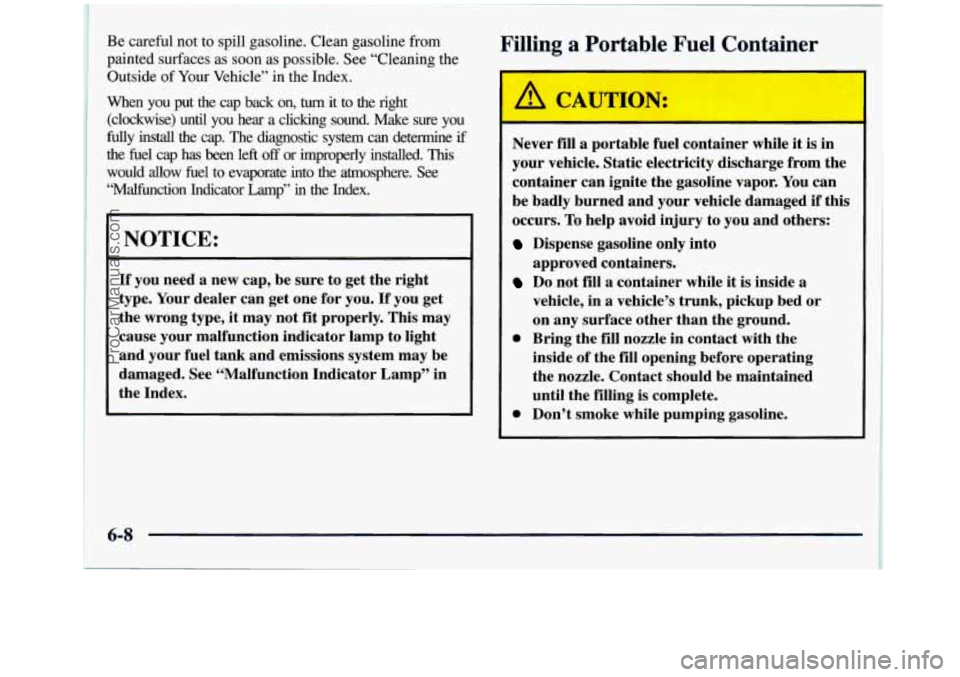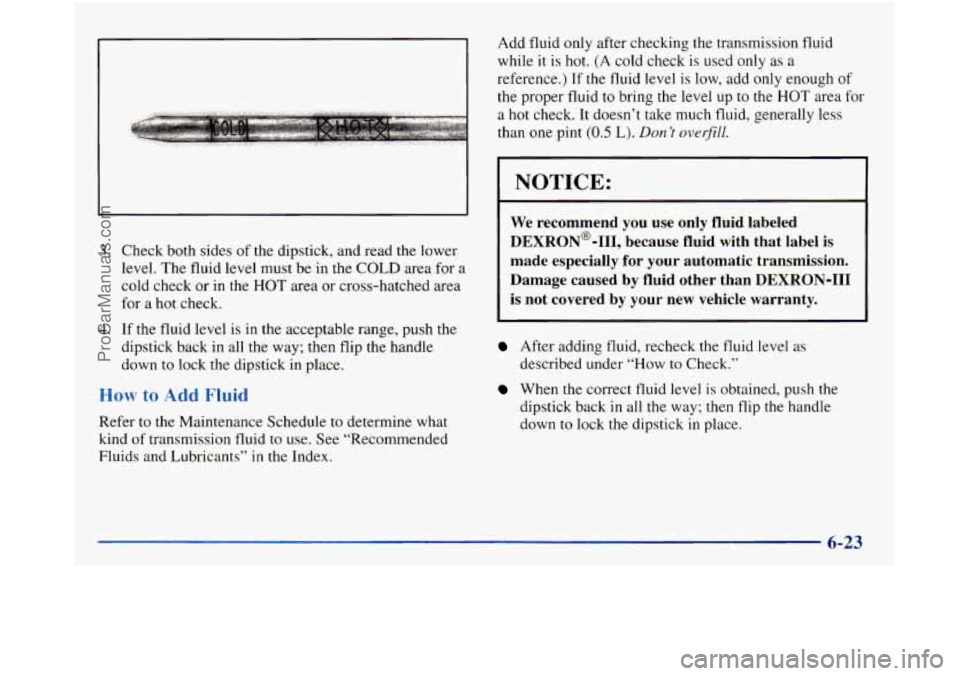Page 272 of 452
How to Add Coolant to the Radiator
1. You can remove the radiator pressure cap when the
cooling system, including the radiator pressure cap and
upper radiator hose,
is no longer hot. Turn the pressure
cap slowly counterclockwise until it first stops. (Don't
press down while
turning the pressure cap.)
2. Then keep turning the pressure cap, but now push
down
as you turn it. Remove the pressure cap.
If you hear
a hiss, wait for that to stop. A hiss means
there is still some pressure left.
5-20
ProCarManuals.com
Page 276 of 452

Changing a Flat Tire
If a tire goes flat, avoid further tire and wheel damage
by driving slowly to a level place. Turn on your hazard
warning flashers.
Changing a tire can cause an injury. The vehicle
can slip off the jack and roll over you or other
people. You and they could be badly injured.
Find
a level place to change your tire. To help
prevent the vehicle from moving:
1. Set the parking brake firmly.
2. Put an automatic transmission shift
lever in PARK
(P) or shift a manual
transmission to FIRST
(1) or
REVERSE (R).
3. If you have a four-wheel-drive vehicle,
be sure the transfer case is in a drive
gear
-- not in NEUTRAL (N).
4. nrn off the engine.
CAUTION: (Continued)
To be even more certain the vehicle won’t move,
you can put blocks
at the front and rear of the
tire farthest away from the one being changed.
That would be the tire on the other side of the
vehicle.
at the opposite end.
V
The following steps will tell you how to use the jack and
change a tire.
ProCarManuals.com
Page 297 of 452
While refueling, let the cap hang by the tether below the
fuel filler neck.
To remove the cap, turn it slowly to the left
(counterclockwise).
If you get gasoline on yourself and then
something ignites it, you could be badly burnea.
Gasoline can spray out on you if you open the
fuel filler cap
too quickly. This spray can happen
if your tank is nearly full, and is more likely in
hot weather. Open the fuel filler cap slowly and
wait for any “hiss” noise to stop. Then unscrew
the cap
all the way.
6-7
ProCarManuals.com
Page 298 of 452

~ Be
careful not to spill gasoline. Clean gasoline from
~ painted surfaces as soon as possible. See “Cleaning the
i Outside of Your Vehicle” in the Index.
When you put
the cap back on, turn it to the right
(clockwise)
until you hear a clicking sound. Make sure you
fully install the cap. The diagnostic system can determine if
the fuel cap has been left off or improperly installed. This
would allow fuel to evaporate into the atmosphere. See
“Malfunction Indicator Lamp”
in the Index.
NOTICE:
If you need a new cap, be sure to get the right
type. Your dealer can get one for you. If you get
the wrong type, it may not
fit properly. This may
cause your malfunction indicator lamp to light
and your fuel tank and emissions system may be
damaged. See ‘LMalfunction Indicator Lamp” in
the Index.
Filling a Portable Fuel Container
Never fill a portable fuel container while it is in
your vehicle. Static electricity discharge from the
container can ignite the gasoline vapor. You can
be badly burned and your vehicle damaged
if this
occurs.
To help avoid injury to you and others:
Dispense gasoline only into
approved containers.
Do not fill a container while it is inside a
vehicle, in
a vehicle’s trunk, pickup bed or
on any surface other than the ground.
inside of the
fill opening before operating
the nozzle. Contact should be maintained
until the filling is complete.
0 Bring the fill nozzle in contact with the
0 Don’t smoke while pumping gasoline.
6-8
I
ProCarManuals.com
Page 313 of 452

3. Check both sides of the dipstick, and read the lower
level. The fluid level must be in the COLD area for a
cold check or in the
HOT area or cross-hatched area
for a
hot check.
4. If the fluid level is in the acceptable range, push the
dipstick back in all the way; then flip the handle
down
to lock the dipstick in place.
io dd Fluid
Refer to the Maintenance Schedule to determine what
kind
of transmission fluid to use. See “Recommended
Fluids and Lubricants”
in the Index. Add
fluid only after checking the transmission fluid
while
it is hot. (A cold check is used only as a
reference.)
If the fluid level is low, add only enough of
the proper fluid
to bring the level up to the HOT area for
a hot check. It doesn’t take much fluid, generally less
than one pint
(0.5 L). Don’t overfill.
I NOTICE:
We recommend you use only fluid labeled
DEXRON@-111, because fluid with that label is
made especially for your automatic transmission.
Damage caused by fluid other than DEXRON-111
is not covered by your new vehicle warranty.
After adding fluid, recheck the fluid level as
described under “How to Check.”
When the correct fluid level is obtained, push the
dipstick back
in all the way; then flip the handle
down to lock the dipstick
in place.
6-23
ProCarManuals.com
Page 332 of 452
Front Turn Signal Lamps
/c
1. Remove the two screws at the inside edge
of the
parkinghurn signal lamp assembly.
2. Remove the lamp assembly by swinging it out from
the inside edge and sliding
it out at the outside edge.
3. Squeeze the tab on the side of the lamp socket while
turning the socket to the left.
4. Pull the socket out of the
lamp assembly.
5. Push in gently on the bulb, turn it to the left and
remove
it from the socket.
6. Put the new bulb into the socket, gently press in on
the bulb and
turn it to the right until it is tight.
7. Put the socket back into the lamp assembly and turn
it to the right until it locks.
8. Put the parkinghrn signal lamp assembly back into
the vehicle and tighten the screws.
6-42
ProCarManuals.com
Page 333 of 452
Front Turn Signal Lamps
(Composite Headlamps)
1. Remove the four screws
and take out the
parking/turn signal
lamp assembly.
2. Squeeze the tab on the side of the lamp socket while
turning the socket
to the left.
4. Push in gently on the bulb, turn it to the left and
remove
it from the socket.
5. Put the new bulb into the socket, gently press in on
the bulb and turn it to the right until it
is tight.
6. Put the socket back into the lamp assembly and turn
it to the right until it locks.
7. Put the parkinghrn signal lamp assembly back into
the vehicle and tighten the four screws.
6-43
ProCarManuals.com
Page 362 of 452
Instrument Panel Fuse Block
The fuse block access door
is on the driver’s side edge
of the instrument panel. Pull
off the cover to access the
fuse block.
You can remove
fuses with a fuse extractor. The fuse
extractor
is mounted to the fuse block access door. To
remove fuses if you don’t have a fuse extractor, hold the
end
of the fuse between your thumb and index finger
and
pull straight out.
You may have spare fuses located behind the fuse block
access door. These can be used to replace a bad fuse.
However, make
sure it is of the correct amperage.
J
D
13
ug
7 I
FuseKircuit
Breaker
1
2
Usage
Stop/TCC Switch, Buzzer,
CHMSL, Hazard Lamps,
S toplamps
Transfer
Case
6-72
ProCarManuals.com